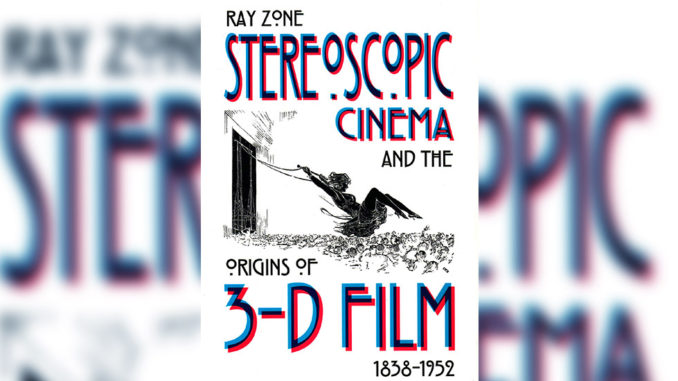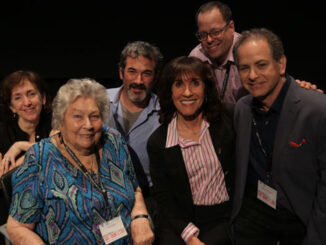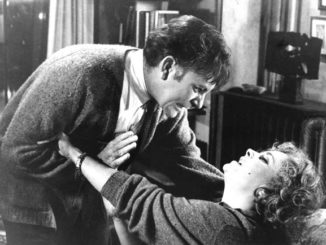
by Betsy A. McLane
Stereoscopc Cinema and the Origins of 3-D Film: 1838-1952
by Ray Zone
The University Press of Kentucky
220 pps., hardbound, $42.00
ISBN: 978-0-8131-2461-2
Note: Although 3D and Stereoscopic are different, for purposes of this review the terms are used interchangeably.
If it was acceptable to begin a book review with Wow!, that’s what I would say about Ray Zone’s Stereoscopic Cinema and the Origins of 3-D Film: 1838-1952. The book is a thorough, precise, comprehensive and deeply revealing analysis of its subject. And perhaps, surprisingly, it is engaging and, to me, inspirational. Did I mention that I like it?
The length of the title hints at the level of scholarship in Stereoscopic Cinema. Both title and text would make any film scholar proud. Zone’s research is awe-inspiring; he has followed the path of 3D cinema via a meticulous history of patents, extant examples of technology and published contemporary reviews in a triumph of primary research. What is more, he has linked these sources together to create a seamless narrative. His exhumation of the myriad number of scientific and practical efforts to achieve visual depth in movies amplifies our understanding of film history. Zone then allows the reader to understand how these efforts have come to shape present-day filmmaking.
Here are two of many examples:
The famous Lumière Brothers’ L’Arrivée d’un Train à La Ciotat, an iconic film, which, shot originally with one of the first motion picture cameras, startled 1896 audiences with its 2D image of a locomotive rushing toward them. What most film histories leave out is that the Lumière Brothers were trying to achieve a 3D image even prior to this first-ever public exhibition of motion pictures. As early as 1900, they patented an “Octagonal Disc Stereo Device” meant to shoot for 3D projection. Although Zone cites disputes about its production date, Louis Lumière eventually re-shot L’Arrivée d’un Train in 3D and exhibited it at a 1935 meeting of the French Academy of Science. This and other 3D tidbits are cited in some film history books, most of which have fallen out of favor (ie, James Limbacher’s once mandatory Four Aspects of the Film, 1969). It is to Zone’s credit that he carefully compares such existing texts to each other and to his own findings, making clear the contradictory accounts that plague early cinema and pre-cinema accounts.
Every section contains fascinating nuggets that underline the genius and perseverance of inventors from Europe, the UK and the US.
Also, Greg Toland’s justly heralded deep-focus cinematography was clearly linked to his fascination with 3D. He shot test footage using a device built by William Alder of Cal Tech that attached to a regular camera. The results were shown to no less a personage than Samuel Goldwyn on the giant screen at Grauman’s Chinese Theatre. Although impressive, the experiment yielded no commercial follow-up. Toland outlined the artistic problems of lighting, camera work and editing for 3D in a 1935 article published in The New York Times. His interest in creating a 3D experience seems obviously linked to his masterwork in many films, including, most famously, Citizen Kane.
There are many more of the delicious surprises that await readers of Stereoscopic Cinema. Zone traces 3D history, not strictly chronologically, but through well-chosen themes such as “Cinema’s Novelty Period,” “Public Exhibition” and “Stereoscopic Cinema Proves Itself.” He allows readers to draw their own conclusions from a myriad of facts, diagrams and quotations from patent applications.
My own few quibbles include the lack of space given to the influence of military applications. Although he mentions Nazi use of a stereoscopic system, and the training applications of 3D used by the US Navy during World War II, the politics and funding for the development of these technologies is not explored. Also, the detail of the lists and old diagrams of patents sometimes become a bit technical. For readers interested in the more human or sociological implications of 3D, some of the lists grow long. Without these, however, the book would not have its compelling power.
Ray Zone’s research is awe-inspiring; he has followed the path of 3D cinema via a meticulous history of patents, extant examples of technology and published contemporary reviews in a triumph of primary research.
Additionally, the many aesthetic issues raised by 3D are addressed only peripherally, and problems of editing in these formidable formats are scarcely mentioned. I am sure that Zone has much to say about these and other artistic concerns, but Stereoscopic Cinema is, admirably, a work of fact, not opinion. Other writers should be inspired to explore these and the many other issues raised by this work.
Every section contains fascinating nuggets that underline the genius and perseverance of inventors from Europe, the UK and the US––traits that provided a continuous impetus for 3D exploration. Russians too, took the plunge, and were perhaps more fully successful than others. Semyon Ivanov used an autostereoscopic system to complete a version of Robinson Crusoe on 70mm in 1941, in the midst of WWII. It, along with other pictures, played in Moscow’s specially constructed 180-seat Stereokino Theatre––for 18 years! Four additional Stereokino houses were eventually built in the Soviet Union.
As a result, no one less than Sergei Eisenstein stated, “To doubt that stereoscopic cinema has its tomorrows, is as naïve as doubting whether there will be tomorrows at all.” Hopefully Ray Zone will document many of those tomorrows in a successor volume that continues the magical story of 3D cinema.






